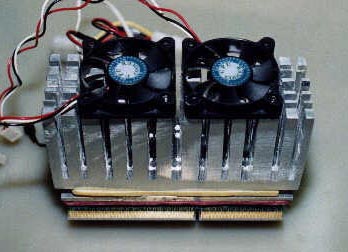
 |
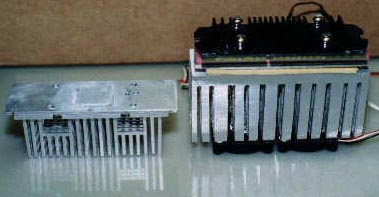
There is a bit of a difference in size.
I started with a comparison of the big sink to the Fullway. As it is easy to see, there is a rather substantial difference in size between the sinks. The Fullway was designed to be an alternative to having to use a fan to assist in removing the heat of the CPU. The pins are long and the space between the pins is enough that convection alone is able to allow the heat to migrate from the metal. I tried, somewhat unsuccessfully, to copy this and leave a fair amount of space between the thick pins of the big sink. At the same time, I tried to keep the sink as massive as space allowed. This heat sink ended up using every available bit of space that was provided around the CPU slot on the BH6. I originally had the pins a bit longer that those in the picture, but with the addition of the 10mm fans, it intruded into 2 of the RAM slots. I cut it back a little and ended up only occupying one of the slots.
If you have never tried to cut a thick piece of metal with a "too thin" band saw blade, I recommend that you keep it that way. The blade tends to twist and wander, no matter how well lubricated or how slowly you feed the stock. Having a band break in the middle of a cut is like a million-toothed serpent on the loose. It was all that I could do to get my fingers, arms, and face as far from that serpent - as fast as I could. It is good for getting the adrenaline going, though.
Take a look at the following pictures and you'll see that for this board in the Inwin A500 case, I have about reached the maximum size heat sink that can be installed. There is only about a half inch of clearance between the sink and the air intake for the power supply. The 2 50mm X 10mm fans are dwarfed by the size of the sink and I have been considering the addition of a third fan.
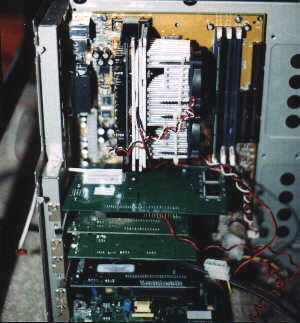
|

|
Given my experiences with not being able to boot into windows at 2.2 volts with the larger cold plate, I decided to measure the temperature of the processor and heat sink from a cold boot. Starting at about a 4°F higher room temperature, the big sink ended up cooler after boot up into Windows. This was expected, but the difference in temperature between the two sinks was not as much as I had imagined it would be. It would appear that mass alone is not the answer.
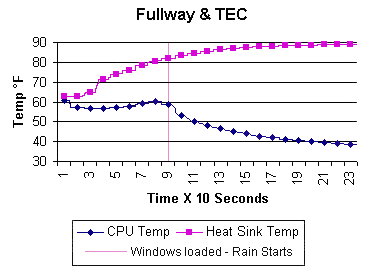 .
.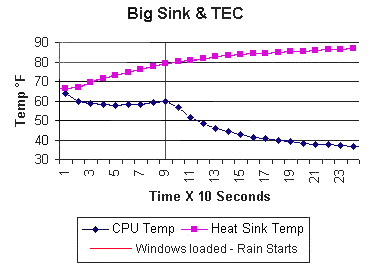
Now, just so you don't think that mass has no place, I will say that the maximum temperature of the sink after running Quake2 in a loop for an hour was a full 8° lower at the sink using the big sink. While this may not seem like a lot, the room temperature during the tests never got over 70°F. When summer rolls around, this may be the difference between stability at 504 and lockups. Differences in processor temperature between the using the Fullway and the big sink ran about 4° in the Quake2 loop. The processor's temperature never exceeded 68°F while running the big sink.
Idle temperatures with Rain running also ran about 4° apart. The big sink will keep the processor at just above the freezing mark. Due to (I think) the large volume of air being forced through the case with its 2 four inch 120 volt fans, I have not had any problem with condensation.
I am now in the process of assembling another heat sink to use while I put the big sink back on to the band saw and try to increase the surface area. Now that I can run at 504, the thought of having to return to 464 is not something I want to do. Spoiled, I guess.
Hopefully I'll have an update in a week or so.
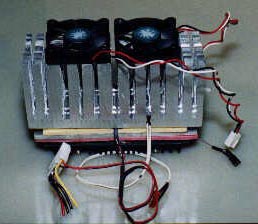 . .
. .